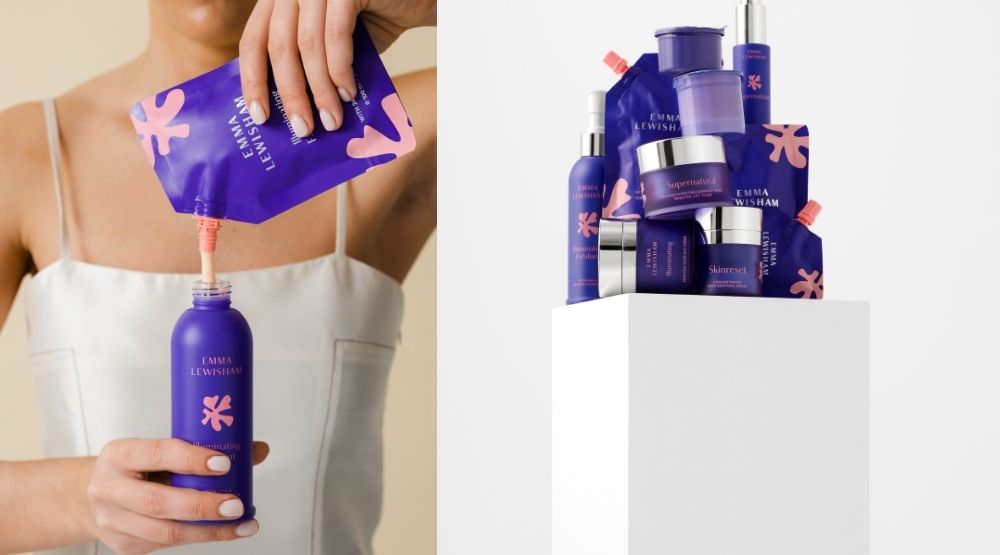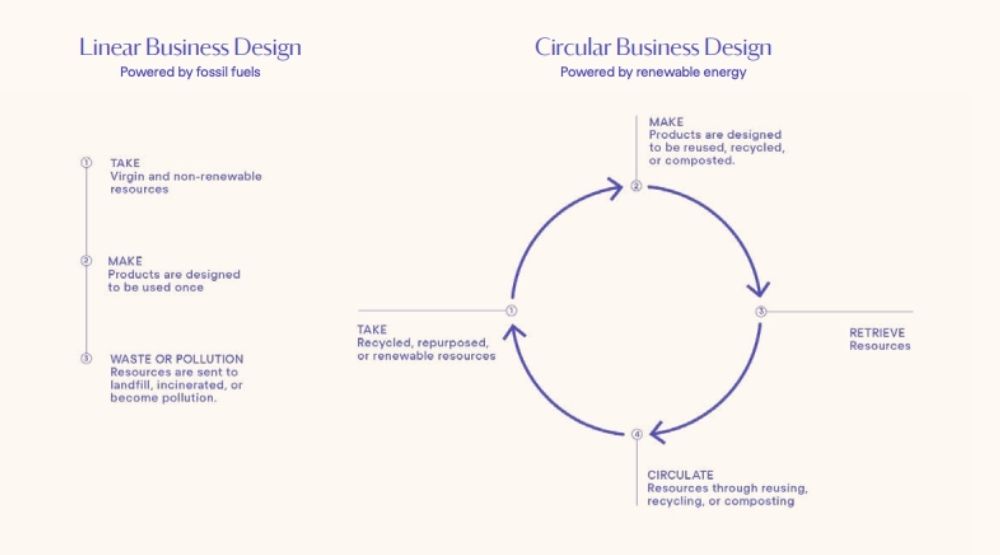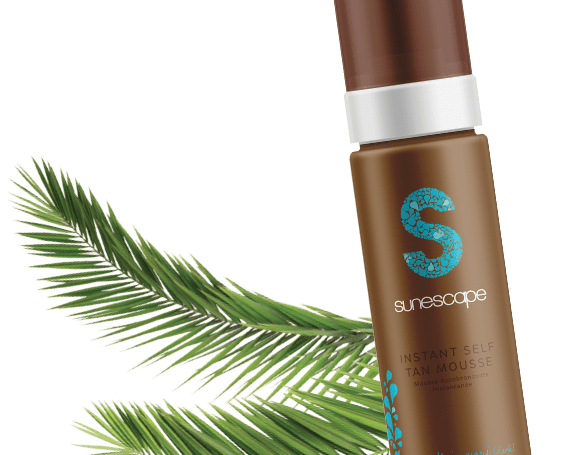
This article first appeared in Professional Beauty, written by Ruby Feneley
Emma Lewisham skincare made headlines last week when it became the world’s first carbon-positive beauty brand. As part of the announcement, its Circular Beauty Roadmap and refillable packaging IP was made public. But what does circular beauty actually mean? And how does intellectual property around packaging impact the global climate crisis? We took a closer look at the trend that will shape the industry (and our planet’s) future.
2021 has been a big year for green beauty. Such a big year that the Competition and Markets Authority are investigating environmental claims made globally by companies inflating their green credentials (turns out up to 40 per cent of green claims you see online, while nice to read about, may not be based in fact) The CMA are pushing for a standardised definition of sustainability terminology via the Green Claims Code – and transparency around practices businesses are putting into action.
Founder and owner of fast-growing New Zealand skincare brand Emma Lewisham, Emma Lewisham has been pushing for this since the inception of her brand, launched in 2019. Earlier this year I spoke to Emma for our sustainability issue, and she told me: “There’s a problem with the notion of ‘sustaining’ in the beauty industry. The planetary crisis we are facing needs to be ‘reversed’ rather than ‘sustained.’ That is why at Emma Lewisham we are committed to a carbon-positive path.” Emma has now achieved her goal, becoming the world’s first carbon-positive beauty brand. Principle to this achievement has been a circular beauty model. But what does it take to build a circular brand in 2021?
Reckoning with recycling:

Recycling is a magic word in the business of beauty. It feels like every other week, breathless press releases come from brands announcing that their products are now fully recyclable or they’ve partnered with a recycler, or they’ve using post-consumer-recycled plastic. Increasingly though, recycling is becoming part of the problem.
The beauty industry contributes 120 billion units of waste per year. Of that staggering figure, only 9% is recycled. While a lot of that 120 billion figure could be recycled, most of it won’t be.
Very simply, recycling is labour intensive and complicated for consumers and expensive for the companies that carry it out. Where the consumer fails, the recyclers will opt to skip recycling altogether. There is danger then that a recycling label can create a false sense of comfort for shoppers that doesn’t translate to action and, perversely, results in more waste.
Emma Lewisham believes companies serious about recycling need to take the pressure off the customer.
“If we are to ensure packaging is recycled, we (brands) must take ownership of our materials and work with our customers to take back all packaging globally to be recycled through specialised recycling partners who ensure this happens. Labelling a beauty product ‘100 per cent recyclable’ without a takeback programme and reputable recycling partner in place – should be considered an irresponsible business practice.”
Emma has long implemented this with the Emma Lewisham Beauty Circle program that encourages customers to return their emptied products to her to be recycled through Terracycle.
But organisations also need to switch goals from recycling to reusability. One of the critical factors for Emma Lewisham reaching it’s carbon positive goal, was finding an alternative to recycling – and this lay with the design team.
The beauty of circular design:

Emma explains that Circular design is the act of designing waste out of the equation. For a beauty brand, this means refillable packaging. Simply, less waste is being delivered to recyclers because the materials are in use for longer.
Lewisham has introduced refillable packaging across the product range, including her award-winning Skin Reset Serum and Sun Shield – the products now come in a tub rather than a tricky to refill or recycle pump. Packaging is the number one contributor to carbon emissions produced by the beauty industry. As evidenced by Emma Lewisham, brand’s can cut their carbon emissions by 70 per cent simply by introducing refillable options.
However, refillable packaging that keeps products fresh is hard to design. Most successful designs, Emma says, are owned by multinationals with the capital to invest them. Emma tells me: “When it comes to developing reusable packaging, most existing designs are patented by large, multinational corporations” – and jealously guarded. After struggling with this herself, Lewisham has elected to share the IP for her refillable packaging publicly.
She says that after 18 months of work and financial investment, “Sharing our blueprint wasn’t a decision I made lightly. The packaging was one of our brand’s competitive advantages.” However, she believes that her efforts will be wasted if other beauty brands don’t join her.
“The problems we face are so much greater than the success of one business or brand. If we’re going to solve them, collaboration is key.” She also hopes smaller brands and startups will benefit from access to her design: “Circular packaging requires investment, it’s expensive so for small brands it’s a barrier.” And then there are the multinationals that need to work backwards,”That can require a huge shift, in some ways a complete overhaul of their business operations.” Emma, who reimagined business processes, technologies and product packaging without a roadmap, hopes the circular beauty blueprint will help major brands catch up.
“Breaking even” carbon credits causing confusion for customers
The second component of building a genuinely carbon positive brand is shifting the goalposts that you’re working towards.
There are two types of carbon certifications issued to businesses – product-level certification and corporate level certification.
Corporate level certification means the business is assessed as a whole. Very high greenhouse gasses emitted from one part of the organisation can be cancelled out by very low greenhouse gasses emitted at another level. The corporation can also invest in carbon offsets, like funding reforestation in other countries, to balance out their carbon-heavy onshore practices. These equations are fraught. Theoretically, a company could be planting trees in Uganda but spilling oil in the pacific ocean. The books might balance, but the system won’t make a dent in the climate crisis.
Cognisant of this, Emma Lewisham has focused on product level certification which leaves no stone unturned. Working alongside Toitu Envirocare, Emma measured the carbon emissions created at each stage of the product life cycle. This required a breakdown of the entire supply chain from the harvesting of raw ingredients to the transportation of products, packaging, and disposal. By measuring emissions at a product level, Emma Lewisham can assign a carbon number to each SKU, demonstrating exactly how many kilograms of carbon were associated with each. All of Emma’s products are created using 100 per cent renewable energy, and Toitu Envirocare has verified that with new, refillable packaging, her products have a 74 per cent smaller carbon footprint. Once emissions have been reduced across the supply chain, measures like recycling and offsetting can make a genuine impact.
Emma Lewisham’s Beauty Circle operation incentivises customers to return any empty Emma Lewisham products they have not refilled to the brand. Here their partner Terracycle will help to correctly recycle them, transforming them into new post-consumer-recycled Emma Lewisham product packaging.
The remainder, and some more, of Emma Lewisham’s carbon footprint, is offset. Working to generate New Zealand’s Puhoi Forest Reserves, supporting Gyapa’s Cook Stoves technology in Ghana, and funding Malya’s wind project in India is helping Emma Lewisham is well and truly “in the green.”


